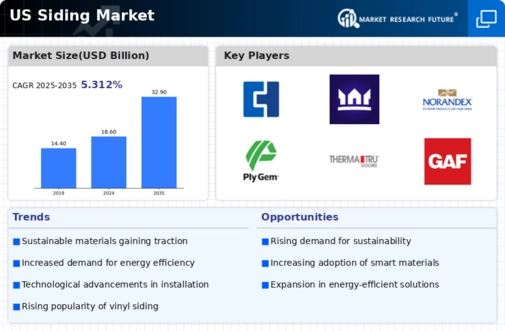Rising Demand for Energy Efficiency
The siding market is experiencing a notable increase in demand for energy-efficient materials. Homeowners are increasingly prioritizing insulation and energy conservation, which has led to a surge in the adoption of insulated siding products. According to recent data, energy-efficient siding can reduce heating and cooling costs by up to 20%. This trend is likely to continue as consumers become more environmentally conscious and seek to lower their utility bills. The siding market is thus adapting to this demand by offering a variety of energy-efficient options, including vinyl and fiber cement siding, which are designed to enhance thermal performance. As energy efficiency becomes a key consideration in home renovations and new constructions, the siding market is poised for growth driven by this consumer preference.
Increased Home Renovation Activities
The siding market is benefiting from a significant rise in home renovation activities across the United States. As homeowners invest in upgrading their properties, the demand for new siding materials is expected to grow. Recent statistics indicate that home improvement spending has increased by approximately 10% annually, with siding being a major focus area. This trend is fueled by the desire to enhance curb appeal, increase property value, and improve energy efficiency. Additionally, the aging housing stock in the US necessitates siding replacements, further driving demand. The siding market is thus positioned to capitalize on this trend, as homeowners seek durable and aesthetically pleasing siding options to rejuvenate their homes.
Growing Preference for Aesthetic Appeal
The siding market is increasingly influenced by homeowners' growing preference for aesthetic appeal in exterior design. As the trend towards personalized home aesthetics gains momentum, consumers are seeking siding options that reflect their individual styles and enhance the overall look of their properties. This shift is evident in the rising popularity of various siding materials, colors, and textures, allowing for greater customization. Recent surveys indicate that nearly 60% of homeowners consider the visual impact of siding as a top priority in their renovation projects. Consequently, manufacturers in the siding market are responding by offering a wider array of design choices, catering to the demand for unique and visually appealing siding solutions.
Technological Advancements in Siding Materials
The siding market is witnessing a wave of technological advancements that enhance the performance and durability of siding materials. Innovations such as advanced coatings, improved manufacturing processes, and the introduction of smart siding options are reshaping the market landscape. For example, new technologies allow for the production of siding that is more resistant to weathering, fading, and impact damage. Additionally, smart siding products equipped with sensors can monitor environmental conditions and provide data to homeowners. These advancements not only improve the longevity of siding but also appeal to tech-savvy consumers looking for modern solutions. As these technologies continue to evolve, the siding market is expected to expand, driven by consumer interest in high-performance materials.
Regulatory Support for Sustainable Building Practices
The siding market is influenced by increasing regulatory support for sustainable building practices. Various state and local governments are implementing stricter building codes and incentives for using environmentally friendly materials. This regulatory environment encourages builders and homeowners to opt for sustainable siding solutions, such as those made from recycled materials or those that contribute to energy efficiency. For instance, certain states offer tax credits for using energy-efficient siding, which can significantly reduce overall project costs. As these regulations become more prevalent, the siding market is likely to see a shift towards more sustainable products, aligning with broader environmental goals and consumer preferences.



















Leave a Comment